 Get premium membership
Get premium membership and access revision papers with marking schemes, video lessons and live classes.
Form 1 Chemistry Notes On Classification Of Substances
Grade/Class: Form 1
Subject: Chemistry
Term: Select Term
Document Type: PDF
Views: 1483
Downloads: 9
Summary
CLASSIFICATION OF SUBSTANCES
Substances are either pure or impure. A pure substance is one which contains only one substance.
An impure substance is one which contains two or more substances. A pure substance is made up of a pure solid, pure liquid or pure gas.
A mixture is a combination of two or more pure substances which can be separated by physical means. The three states of matter in nature appear mainly as mixtures of one with the other.
Common mixtures include:
a) Solutions/solid-liquid dissolved mixture
Experiment:
To make a solution of copper (II) sulphate (VI) / Potassium manganate (VII) /sodium chloride Procedure
Put about 100 #cm^3# of water in three separate beakers. Separately place a half spatula end full of copper (II) sulphate (VI), Potassium manganate (VII) and sodium chloride crystals to each beaker. Stir for about two minutes.
Observation
Copper (II) sulphate (VI) crystals dissolve to form a blue solution
Potassium manganate (VII) crystals dissolve to form a purple solution
Sodium chloride crystals dissolve to form a colourless solution
Explanation
Some solids, liquids and gases dissolve in some other liquids.
A substance/liquid in which another substance dissolves is called solvent.
A substance /solid /gas which dissolves in a solvent is called solute.
When a solute dissolves in a solvent it forms a uniform mixture called solution. A solute dissolved in water as the solvent exists in another state of matter called aqueous state. Water is referred as the universal solvent because it dissolves many solutes. A solute that dissolves in a solvent is said to be soluble. Soluble particles uniformly spread between the particles of water/solvent and cannot be seen.
Solute + Solvent → solution
Solute + Water → Aqueous solution of solute
The solute dissolved in water gives the name of the solution
e. g.
Sodium chloride solution is a solution formed after dissolving sodium chloride crystals/solid in water. Sodium chloride exists in aqueous state after dissolving.
Sodium chloride + Water → Sodium chloride solution
#NaCl_(s) + H_(2)O_(aq) → NaCl_(aq)#
Ammonia solution is a solution formed after dissolving ammonia gas in water.
Ammonia exists in aqueous state after dissolving.
Ammonia gas + Water → Aqueous ammonia
#NH_(3(g)) + H_(2)O_(aq) → NH_(3(aq))#
3. Copper (II)sulphate(VI) solution is a solution formed after dissolving Copper(II) sulphate (VI) crystals/solid in water. Copper (II)sulphate(VI) exist in aqueous state after dissolving.
Copper (II)sulphate(VI) + Water -> Copper (II)sulphate(VI) solution
#CuSO_(4(s)) + H_(2)O_(aq) → CuSO_(4 (aq))#
4. Potassium manganate(VII) solution is a solution formed after dissolving Potassium manganate(VII) crystals/solid in water.
Potassium manganate(VII)exist in aqueous state after dissolving.
Potassium manganate(VII) + Water → Potassium manganate(VII) solution
#KMnO_(4(s)) + H_(2)O_(aq) → KMnO_(4 (aq))#
b) Suspension/ precipitates/solid-liquid mixture which do not dissolve
Experiment: To make soil, flour and Lead (II) Iodide suspension/precipitate
Procedure
Put about 100 #cm^3# of water in three separate beakers. Separately place a half spatula end full of soil, maize and lead (II) Iodide to each beaker. Stir for about two minutes.
Observation
Some soil, maize and lead (II) Iodide float in the water
A brown suspension/precipitate/particles suspended in water containing soil
A white suspension/precipitate/particles suspended in water containing flour. A yellow suspension/precipitate/particles suspended in water containing Lead (II) iodide.
Some soil, maize and lead (II) Iodide settle at the bottom after some time.
Explanation
Some solid substances do not dissolve in a liquid. They are said to be insoluble in the solvent .When an insoluble solid is put in liquid:
Some particles remain suspended/floating in the liquid to form a suspension /precipitate.
Some particles sink/settle to the bottom to form sediments after being allowed to stand.
An insoluble solid acquire the colour of the suspension/precipitate .e.g.
A white suspension /precipitate has some fine white particles suspended /floating in the liquid. Not “white solution”
A blue suspension /precipitate has some fine blue particles suspended /floating in the liquid.
A green suspension /precipitate has some fine green particles suspended /floating in the liquid.
A brown suspension /precipitate has some fine brown particles suspended /floating in the liquid.
A yellow suspension /precipitate has some fine yellow particles suspended /floating in the liquid.
c (i) Miscibles /Liquid-liquid mixtures
To form water-ethanol and Kerosene-turpentine miscibles
Procedure
Measure 50#cm^3# of ethanol into 100#cm^3# beaker. Measure 50#cm^3# of water. Place the water into the beaker containing ethanol. Swirl for about one minute.
Measure 50#cm^3# of kerosene into 100#cm^3# beaker. Measure 50#cm^3# of turpentine oil. Place the turpentine oil into the beaker containing kerosene. Swirl for about one minute.
Observation
Two liquids do not form layers.
Ethanol and water form a uniform mixture.
Kerosene and turpentine oil form uniform mixture
Explanation
Ethanol is miscible in Water. Kerosene is miscible in turpentine oil. Miscible mixture form uniform mixture. They do not form layers. The particles of one liquid are smaller than the particles of the other. The smaller particles occupy the spaces between the bigger particles.
(ii) Immiscibles /Liquid-liquid mixtures
To form water-turpentine oil and Kerosene-water miscibles
Procedure
Measure 50#cm^3# of water into 100#cm^3# beaker. Measure 50#cm^3# of turpentine oil. Place the oil into the beaker containing water. Swirl for about one minute.
Measure #50cm^3# of water into 100#cm^3# beaker. Measure 50#cm^3# of kerosene. Place the kerosene into the beaker containing water. Swirl for about one minute.
Observation
Two liquids form layers.
Turpentine and water do not form a uniform mixture.
Water and kerosene do not form uniform mixture
Explanation
Kerosene is immiscible in Water. Water is immiscible in turpentine oil. Immiscible mixtures do not form uniform mixtures. They form layers. The size of the particles of one liquid is almost equal to the particles of the other. The particles of one liquid cannot occupy the spaces between the particles of the other. The heavier particles settle at the bottom. The less dense particles settle on top.
(d) Solid-solid mixtures/Alloys
Before solidifying, some heated molten/liquid metals dissolve in another metal to form a uniform mixture of the two. On solidifying, a uniform mixture of the metals is formed. A uniform mixture of two metals on solidifying is called alloy. In the alloy, one metallic particle occupies the spaces between the metallic particles of the other.
Common alloys of metal.
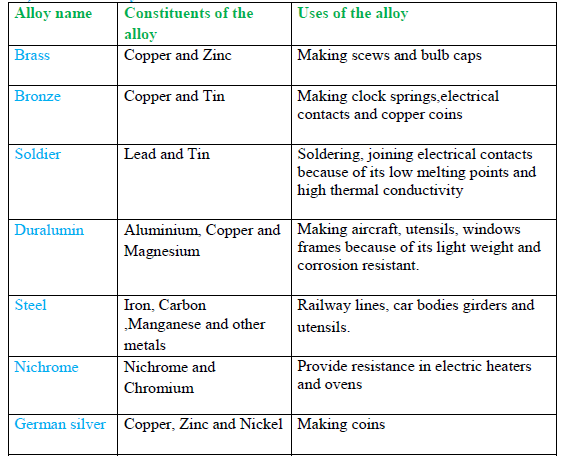
METHODS OF SEPARATING MIXTURES
Mixtures can be separated from applying the following methods:
a) Decantation
Sediments can be separated from a liquid by pouring out the liquid. This process is called decantation.
Experiment
Put some sand in a beaker. Add about 200#cm^3# of water. Allow sand to settle. Pour off water carefully into another beaker.
Observation
Sand settles at the bottom as sediments. Less clean water is poured out.
Explanation
Sand does not dissolve in water. Sand is denser than water and thus settles at the bottom as sediment. When poured out, the less dense water flows out.
b) Filtration
Decantation leaves suspended particles in the liquid after separation. Filtration is thus improved decantation.
Filtration is the method of separating insoluble mixtures/particles/solids from a liquid.
Experiment
To separate soil and water using filtration
Procedure
Fold a filter paper to fit well into a filter funnel. Place the funnel in an empty 250 #cm^3# beaker.
Put one spatula end full of soil into 50#cm^3# of water. Stir. Put the soil/water mixture into the filter funnel.
Observations
Clean water is collected below the filter funnel.
Soil remains above the filter paper.
Explanation
A filter paper is porous which act like a fine sieve with very small holes. The holes allow smaller water particles to pass through but do not allow bigger soil particles. The liquid which passes through is called filtrate. The solid which do not pass through is called residue.
Set up of apparatus
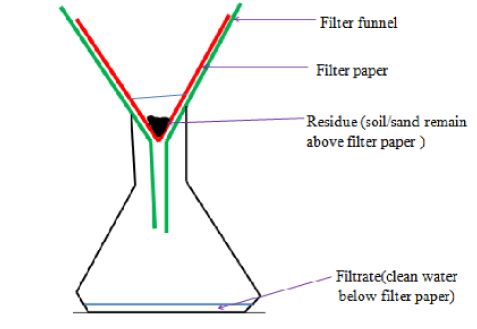
In industries, filtration is used in engine filters to clean up air.
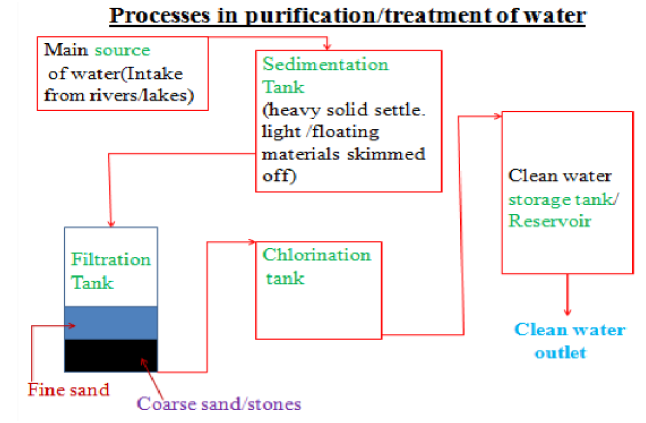
c) Evaporation
Evaporation is a method of separating a solute/solid from its solution. This involves heating a solution (solvent and solute) to vapourize the solvent out of the solution mixture leaving pure solute/solid. If a mixture contain insoluble solid, they are filtered out.
Experiment
To separate a mixture of soil and salt (sodium chloride).
Procedure
Put one spatula end full of soil on a filter paper.
Put one spatula full of common salt/sodium chloride into the same filter paper. Mix well using the spatula.
Place about 200#cm^3# of water into a beaker.
Put the contents of the filter paper into the water. Stir thoroughly using a glass/stirring rod for about one minute.
Fold a filter paper into a filter funnel.
Pour half portion of the contents in the beaker into the filter funnel. Put the filtrate into an evaporating dish. Heat on a water bath.
Observation
(i) On mixing
Colourless crystals and brown soil particles appear on the filter paper.
(ii) On adding water
Common soil dissolves in water. Soil particles do not dissolve in water.
(iii) On filtration
Colourless liquid collected as filtrate below the filter funnel/paper.
Brown residue collected above the filter funnel/paper.
(iv) On evaporation
Colourless crystals collected after evaporation
Explanation
Solid mixture of sand and common salt take the colours of the two.
On adding water, common salt dissolve to form a solution.
Soil does not because it is insoluble in water and thus forms a suspension.
On filtration, a residue of insoluble soil does not pass through the filter paper.
It is collected as residue.
Common salt solution is collected as filtrate.
On heating the filtrate, the solvent/water evaporate/vapourize out of the evaporating dish leaving common salt crystals.
Vapourization/evaporation can take place even without heating.
This is the principle/process of drying wet clothes on the hanging line.
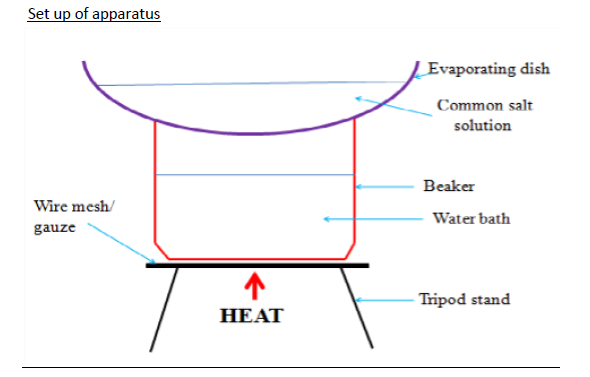
d) Distillation
Distillation is an improved evaporation where both the solute and the solvent in the solution are separated /collected. Distillation therefore is the process of separating a solution into constituent solid solute and the solvent. It involves heating the solution to evaporate/vapourize the solvent out. The solvent vapour is then condensed back to a liquid.
Experiment
To obtain copper (II) sulphate (VI) crystals and water from copper (II) sulphate (VI) solution.
Procedure
Put one spatula end full of copper (II) sulphate (VI) crystals into a 250#cm^3# beaker.
Place about 200#cm^3# of water into the beaker.
Stir thoroughly using a glass/stirring rod for about one minute.
Pour half portion of the contents in the beaker into a round bottomed/flat/conical flask broken porcelain/sand/glass into the flask.
Put a few pieces of b Stopper the flask.
Connect the flask to a Liebig condenser using delivery tube.
Place a 200#cm^3# clean empty beaker/conical flask as a receiver at the end of the Liebig condenser.
Circulate water in the Liebig condenser.
Heat the flask strongly on a tripod stand with wire mesh/gauze until there is no more visible boiling bubbles in the flask.
Observation
Copper (II)sulphate (VI) crystals dissolve in water to form a blue solution.
On heating, colourless liquid is collected in the receiver. Blue crystals are left in the flask. (if gently heated further, the blue crystals turn to white powder)
Explanation
On heating blue Copper (II) sulphate (VI) solution, the colourless liquid solvent evaporate/vapourize.
The liquid vapour/gas passes through the delivery tube to the liebig condenser. The Liebig condenser has a cold water inlet near the receiver and cold water out let.
This ensures efficient cooling. If the cold water outlet/inlet is reversed, the water circulation would be less efficient.
The water in the receiver would be warm. In the Liebig condenser, the cold water, condenses the liquid vapour into liquid. The condensed liquid collects in the receiver as distillate.
The solute of blue Copper (II) sulphate (VI) crystals is left in the flask as residue. During simple distillation, therefore, the solution is heated to vapourize /evaporate the solvent/one component which is condensed at a different part of the apparatus.
The purpose of pieces of broken porcelain/porous pot/glass/sand/ is to:
(i) prevent bumping of the solution during boiling.
(ii) ensure smooth and even boiling.
Salty sea water can be made pure through simple distillation.
Any mixture with a large difference /40°C in boiling point can be separated using simple distillation.
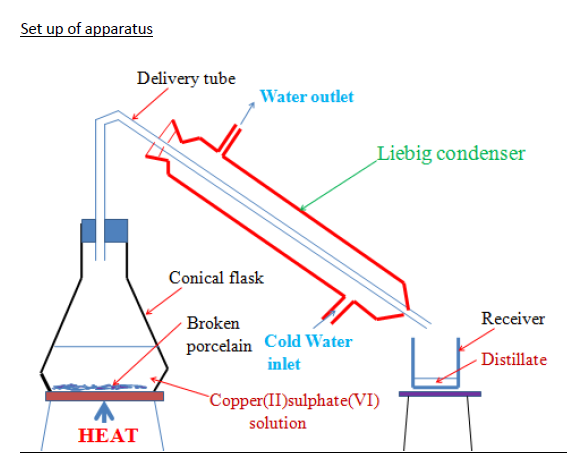
e) Fractional distillation
Fractional distillation is an improved simple distillation used specifically to separate miscible mixtures with very close /near boiling points.
Fractional distillation involves:
(i) Heating the mixture in a conical/round bottomed /flat bottomed flask. The pure substance with a lower boiling point and thus more volatile evaporates/boils/vapourizes first. e.g. Pure ethanol has a boiling point of 78°C.Pure water has a boiling point of 100 °C at sea level/one atmosphere pressure. When a miscible mixture of ethanol and water is heated, ethanol vapourizes /boils/ evaporates first because it is more volatile.
(ii) The conical/round bottomed /flat bottomed flask is connected to a long glass tube called fractionating column.
The purpose of the fractionating column is to offer areas of condensation for the less volatile pure mixture.
The fractionating column is packed with glass beads/broken glass/ porcelain/ shelves to increase the surface area of condensation of the less volatile pure mixture.
(iii) When the vapours rise they condense on the glass beads/broken glass /porcelain / shelves which become hot.
When the temperature of the glass beads/broken glass/porcelain/shelves is beyond the boiling point of the less volatile pure substance, the pure substance rise and condensation take place on the glass beads/broken glass/porcelain/shelves at a higher level on the fractionating column.
The less volatile pure substance trickles/drips back down the fractionating column or back into the conical/round bottomed /flat bottomed flask to be heated again. e.g.
If the temperature on glass beads/broken glass/porcelain/shelves is beyond 78°C, the more volatile pure ethanol rise to condense on the glass beads/broken glass /porcelain/shelves higher in the fractionating column.
Water condenses and then drip/trickle to the glass beads/broken glass /porcelain /shelves lower in the fractionating column because it is less volatile.
(iv) The fractionating column is connected to a Liebig condenser. The Liebig condenser has a cold water inlet and outlet circulation.
The more volatile mixture that reach the top of the fractionating column is condenses by the Liebig condenser into a receiver. It is collected as the first fraction.
(v) At the top of the fractionating column, a thermometer is placed to note/monitor the temperature of the boiling mixtures.
Pure substances have constant/fixed boiling point. When one mixture is completely separated, the thermometer reading rises.
E.g. The thermometer reading remains at78°C when ethanol is being separated. When no more ethanol is being separated, the mercury/alcohol level in the thermometer rises.
(vi) The second /subsequent fractions are collected in the receiver after noting a rise the mercury/alcohol level in the thermometer. e.g.
The thermometer reading rises to 100°C when water is being separated. It is passed through the Liebig condenser with the cold water inlet and outlet circulation.
It is collected different receiver as the second/subsequent fraction.
(vii) Each fraction collected should be confirmed from known physical/chemical properties/characteristic. e.g.
Ethanol
Ethanol is a colourless liquid that has a characteristic smell .When it is put in a watch glass then ignited, it catches fire and burn with a blue flame.
Water
Water is a colourless liquid that has no smell/odour .When it is put in a watch glass then ignited, it does not catch fire.
Set up of apparatus
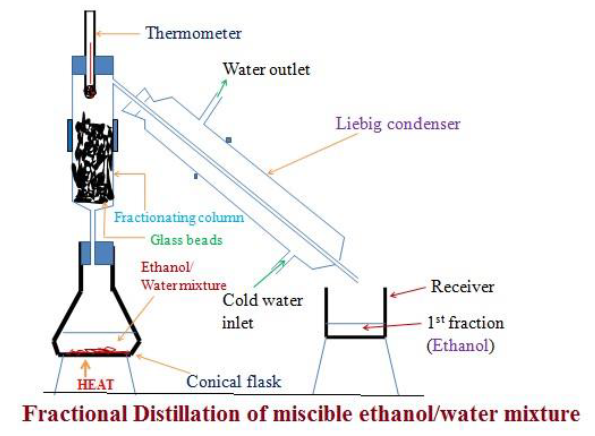
Industrial application of Fractional distillation
On a large scale, fractional distillation is used:
(i) In fractional distillation of crude oil in an oil refinery.
Crude oil is a mixture of many fractions. When heated in a furnace, the different fractions separate out according to their boiling point. In Kenya, fractional distillation takes place at Changamwe in Mombasa.
(ii) In fractional distillation of air.
Air contain a mixture of three main useful gases which are condensed by cooling to very low temperature (-200°C) to form a liquid. The liquid is then heated. Nitrogen is the most volatile (-196 °C) and thus comes out as the first fraction. Argon (at -186 °C) is the second fraction. Oxygen (at -183 °C) is the last fraction. The three gases are very useful industrial gases.
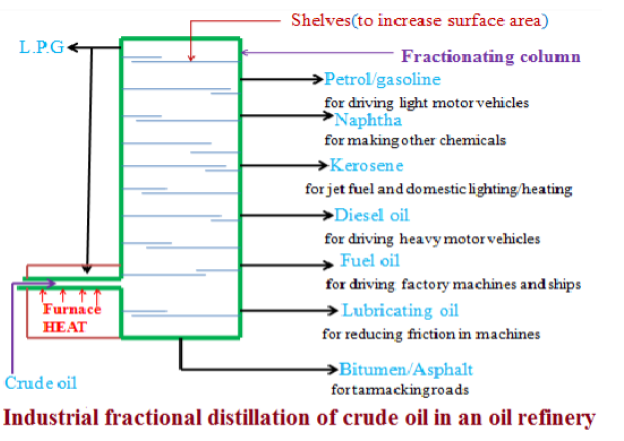
f) Separation of immiscibles (Using a separating funnel)
Two or more liquids that form layers on mixing are immiscible. Immiscible mixture arrange themselves according to their densities
i.e The denser liquid sink to the bottom. The less dense liquid floats on the denser one. Immicible mixtures can be separated from each other by using a separating funnel.
Experiment
To separate an immiscible mixture of paraffin and water.
Procedure
Place about 100cm3 of water into a 250#cm^3# beaker. Add about 100#cm^3# of paraffin into the beaker. Stir.
Transfer the mixture into a separating funnel. Allow to settle for about one minute. Open the tap, run out the lower layer out slowly into a clean beaker. Close the tap when the upper layer is very close to the tap.
Run out the intermediate small amount of the mixture near the tap into a beaker. Discard it.
Run out the remaining upper layer into a fresh beaker.
Place a portion of upper and lower layer into a watch glass separately after separating each. Ignite.
Observation
Water and paraffin are both colourless liquids.
Two layers are formed on mixing.
Colourless odourless liquid collected first. It does not catch fire.
A colourless liquid with characteristic smell collected later/second. It catches fire and burn with a yellow smoky flame.
Explanation
Water and paraffin are immiscible. Water is denser than paraffin. When put in a separating funnel, paraffin float on water. On opening the tap, water runs out. A mixture of water and paraffin at the junction of the two is discarded. It is not pure.
Set up of apparatus
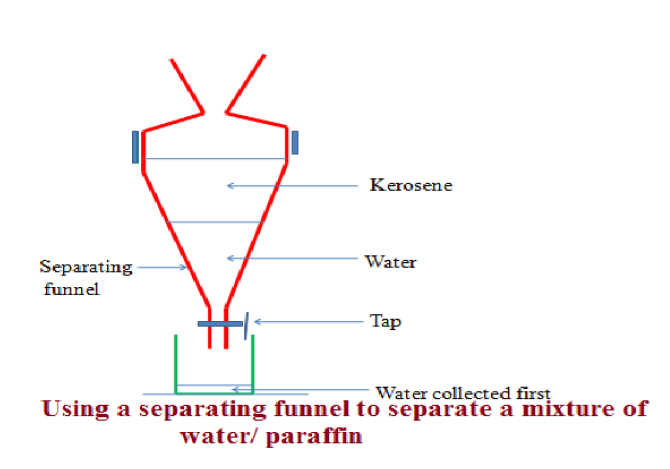
g) Sublimation/deposition
Some solids on heating do not melt to a liquid but change directly to a gas. The process by which a solid changes to a gas is called sublimation. The gas cools back and changes directly to a solid. The process by which a gas changes to a solid is called deposition. Sublimation and deposition therefore are the same but opposite processes.
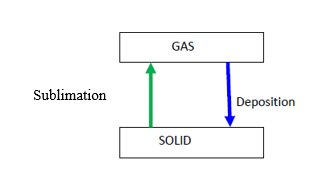
Some common substances that undergo sublimation/ deposition include:
(i) Iodine
(ii) Carbon (IV) oxide
(iii) Camphor
(iv) Ammonium chloride
(v) Iron (III) chloride
(vi) Aluminium (III) chloride
(vii) Benzoic acid
If a mixture has any of the above as a component, then on heating it will change to a gas and be deposited away from the source of heating.
Procedure
Place about one spatula full of ammonium chloride crystals into a clean dry 100#cm^3# beaker. Add equal amount of sodium chloride crystals into the beaker.
Swirl to mix.
Place the beaker on a tripod stand.
Put about 100#cm^3# of water into another beaker. Place carefully the beaker containing water on top of the beaker containing the solid mixture. Light/ignite a burner and heat the solid.
Set up of apparatus:
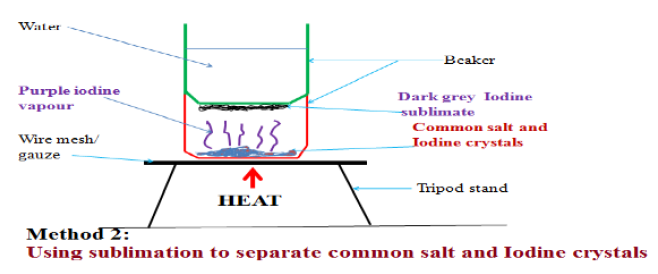
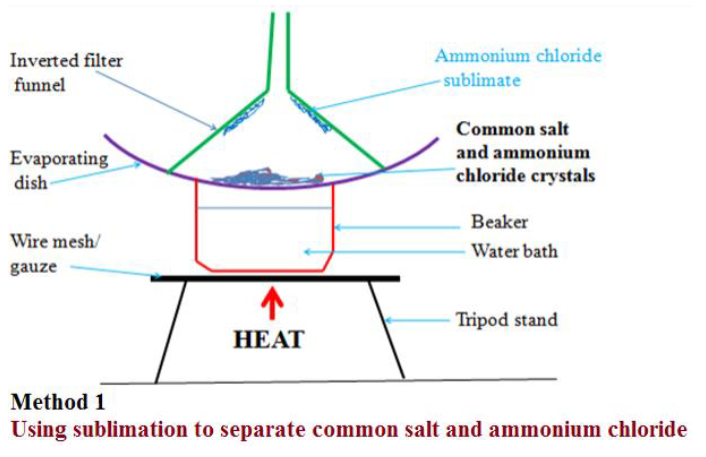
Observation
(i) With ammonium chloride/common salt mixture White fumes produced.
White sublimate deposited
Colourless residue left
(ii) With Iodine/common salt mixture Purple fumes produced .
Dark grey sublimate deposited
Colourless residue left
Explanation
(i) On heating a mixture of ammonium chloride and common salt, a white fumes of ammonium chloride is produced. The white fumes solidify as white sublimate on the cooler parts. Common salt remains as residue.
Chemical equation:
Ammonium chloride (solid)  Ammonium chloride (gas)
Ammonium chloride (gas)
#NH_(4)Cl_(s)#  #NH_(4)Cl_(g)#
#NH_(4)Cl_(g)#
On heating a mixture of Iodine and common salt, a purple fumes of Iodine vapour is produced. The purple fumes solidify as dark grey sublimate on the cooler parts. Common salt remains as residue.
Chemical equation:
Iodine (solid)  Iodine (gas)
Iodine (gas)
#I_(2(s)#  #I_(2 (g)#
#I_(2 (g)#
h) Chromatography
Chromatography is a method of separating components of a solution mixture by passing it through a medium where the different components move at different rates. The medium through which the solution mixture is passed is called absorbent material.
Paper chromatography is a method of separating coloured dyes by using paper as the absorbent material.
Since dyes are insoluble/do not dissolve in water, ethanol and propanone are used as suitable solvents for dissolving the dye.
Practically, a simple paper chromatography involve placing a dye/material on the absorbent material, adding slowly a suitable soluble solvent on the dye/material using a dropper, the solvent spread out on the absorbent material carrying the soluble dye away from the origin.
The spot on which the dye is initially/originally placed is called baseline. The farthest point the solvent spread is called solvent front. The farthest a dye can be spread by the solvent depend on:
(i) Density of the dye-the denser the dye, the less it spread from the basely ne by the solvent.
(ii) Stickiness of the dye-some dyes sticks on the absorbent material more than other thus do not spread far from baseline.
Experiment
To investigate the colours in ink
Procedure
Method 1
Place a filter paper on an empty beaker. Put a drop of black/blue ink in the centre of the filter paper. Wait for about one minute for the ink drop to spread. Using a clean teat pipette/dropper add one drop of ethanol/propanone. Wait for about one minute for the ink drop to spread further. Add about twenty other drops of ethanol waiting for about one minute before each addition. Allow the filter paper to dry.
Experiment
To investigate the colours in ink
Procedure
Method 2
Cut an 8 centimeter thin strip of a filter paper. At about 3cm on the strip, place a drop of ink. Place the filter paper in a 10cm length boiling tube containing 5#cm^3# of ethanol. Ensure the cut strip of the filter paper just dips into the ethanol towards the ink mark. Cover the boiling tube. Wait for about twenty minutes. Remove the boiling tube and allow the filter paper to dry.
Set up of apparatus
Method 1
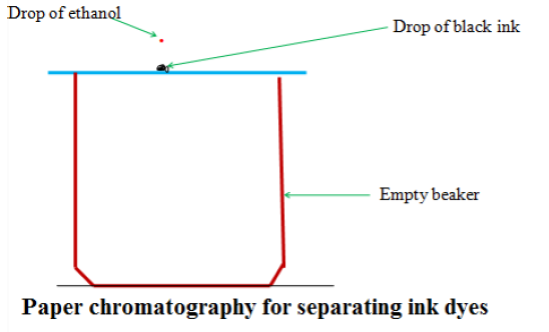
Set up of apparatus
Method 2
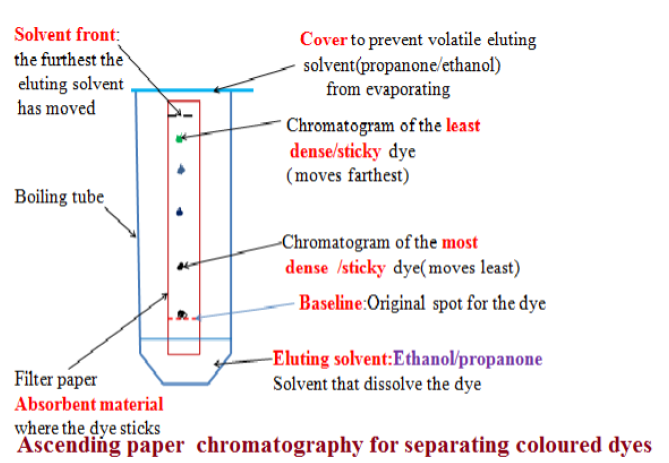
Explanation
When a drop of ink is placed on an absorbent material it sticks. On adding an eluting solvent, it dissolves the dye spread out with it. The denser and sticky pure dye move least. The least dense/sticky pure dye move farthest. A pure dye will produce the same chromatogram/spot if the same eluting solvent is used on the same absorbent material. Comparing the distance moved by a pure dye with a mixture, the coloured dyes in a mixture can be deduced as below:
Example 1
The chromatogram of pure dyes A, B ,C and a dye mixture D is shown below Determine the pure dyes present in D. On the diagram show:
(i) the solvent front
(ii) baseline
(iii) the most soluble pure dye
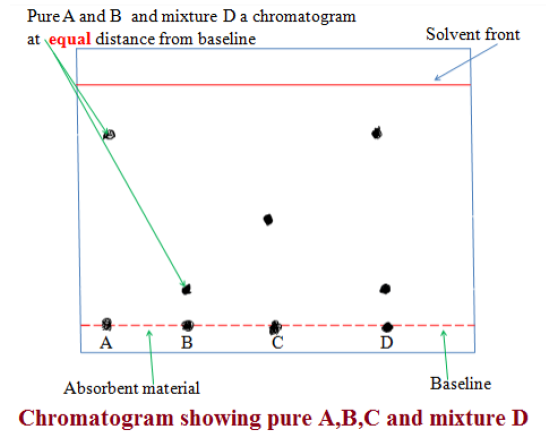
i) Solvent extraction
Solvent extraction is a method of separating oil from nuts/seeds. Most nuts contain oil. First the nuts are crushed to reduce their size and increase the surface area. A suitable volatile solvent is added. The mixture is filtered. The filtrate solvent is then allowed to crystallize leaving the oil/fat. If a filter paper is rubbed/smeared with the oil/fat, it becomes translucent. This is the test for the presence of oil/fat.
Experiment:
To extract oil from Macadamia nut seeds
Procedure
Crush Macadamia nut seeds form the hard outer cover .Place the inner soft seed into a mortar. Crush (add a little sand to assist in crushing).
Add a little propanone and continue crushing. Continue crushing and adding a little propanone until there is more liquid mixture than the solid. Decant/filter. Put the filtrate into an evaporating dish. Vapourize the solvent using solar energy /sunlight. Smear/rub a portion of the residue left after evaporation on a clean dry filter paper.
Observation /Explanation
Propanone dissolve fat/oil in the macadamia nuts. Propanone is more volatile (lower boiling point) than oil/fat. In sunlight/solar energy, propanone evaporate/vapourize leaving oil/fat (has a higher boiling point).Any seed like corn, wheat , rice, soya bean may be used instead of macadamia seed. When oil/fat is rubbed/ smeared on an opaque paper, it becomes translucent.
j Crystallization
Crystallization is the process of using solubility of a solute/solid to obtain the solute/solid crystals from a saturated solution by cooling or heating the solution. A crystal is the smallest regular shaped particle of a solute. Every solute has unique shape of its crystals.
Some solutions form crystals when heated. This is because less solute dissolve at higher temperature. Some other solutions form crystals when cooled. This is because less solute dissolve at lower temperature.
Experiment
To crystallize copper (II) sulphate (VI) solution
Procedure
Place about one spatula full of hydrated copper sulphate (VI) crystals into 200#cm^3# of distilled water in a beaker. Stir. Continue adding a little more of the hydrated copper sulphate (VI) crystals and stirring until no more dissolve. Decant/filter. Cover the filtrate with a filter paper. Pierce and make small holes on the filter paper cover. Preserve the experiment for about seven days.
Observation/Explanation
Large blue crystals formed
When hydrated copper(II)sulphate crystals are placed in water, they dissolve to form copper(II)sulphate solution. After some days water slowly evaporate leaving large crystals of copper(II)sulphate. If the mixture is heated to dryness, small crystals are formed.
Physical/Temporary and Chemical changes
A physical/temporary change is one which no new substance is formed and is reversible back to original.
A chemical/permanent change is one which a new substance is formed and is irreversible back to original.
The following experiments illustrates physical and chemical changes
a) Heating ice
Place about 10g of pure ice in a beaker. Determine its temperature. Record it at time “0.0” in the table below. Heat the ice on a strong Bunsen flame and determine its temperature after every 60seconds/1minute to complete the table below:

Plot a graph of time against Temperature (y-axis)
Explain the shape of your graph
Melting/freezing/fusion/solidification and boiling /vaporization /evaporation are the two physical processes.
Melting /freezing point of pure substances is fixed /constant.
The boiling point of pure substance depend on external atmospheric pressure.
Melting/fusion is the physical change of a solid to liquid.
Freezing is the physical change of a liquid to solid.
Melting/freezing/fusion/solidification are therefore two opposite but same reversible physical processes i.e
Boiling/vaporization/evaporation is the physical change of a liquid to gas.
Condensation/ liquidification is the physical change of gas to liquid.
Boiling/vaporization/evaporation and condensation/ liquidification are therefore two opposite but same reversible physical processes
Practically
(i) Melting/liquidification/fusion involves heating a solid to weaken the strong bonds holding the solid particles together.
Solids are made up of very strong bonds holding the particles very close to each other (Kinetic Theory of matter).
On heating these particles gain energy/heat from the surrounding heat source to form a liquid with weaker bonds holding the particles close together but with some degree of freedom.
(ii) Freezing/fusion/solidification involves cooling a liquid to reform /rejoin the very strong bonds to hold the particles very close to each other as solid and thus lose their degree of freedom (Kinetic Theory of matter).
Freezing /fusion / solidification is an exothermic (-ΔH)process that require particles holding the liquid together to lose energy to the surrounding.
(iii) Boiling/vaporization/evaporation involves heating a liquid to completely break/free the bonds holding the liquid particles together.
Gaseous particles have high degree of freedom (Kinetic Theory of matter). Boiling /vaporization / evaporation is an endothermic (+ΔH) process that require/absorb energy from the surrounding.
(iv) Condensation/liquidification is reverse process of boiling /vaporization / evaporation.
It involves gaseous particles losing energy to the surrounding to form a liquid.
More Notes